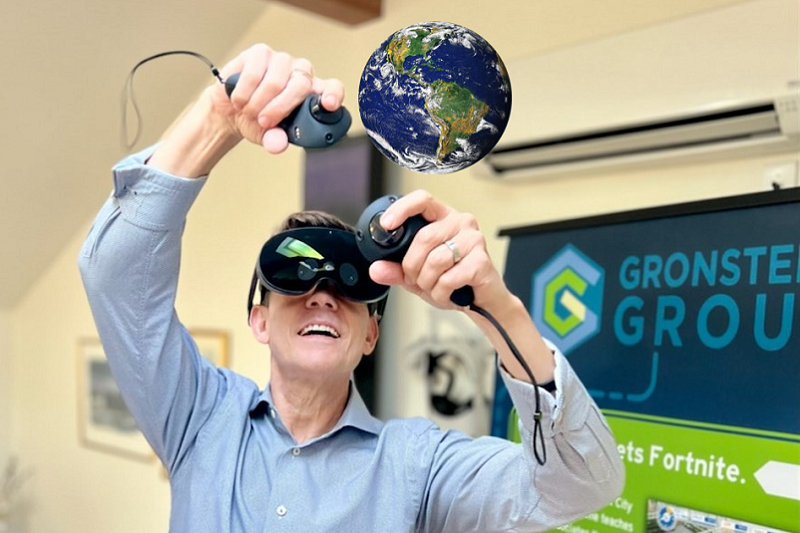ATD Blog
Meta Quest Pro: Mixed Reality Enters Enterprise Learning
Tue Nov 08 2022

Meta CEO Mark Zuckerberg (and his avatar) recently launched the company’s first enterprise mixed-reality headset to great fanfare. Now, it’s up to learning leaders to decide whether this new tech will herald a new immersive learning era.
The “Quest Pro” isn’t just a virtual reality (VR) headset that can transport pharmacists to a lab where they can practice mixing medication and teleport drywallers to a construction site where they can mix mud—it’s also a bridge to “mixed reality,” where virtual objects appear in the physical world around us. An in-person class can spawn a virtual product into the middle of the room and view its inner workings with x-ray vision while the students and instructors still see each other in real life. While VR can put you anywhere, mixed reality can bring anything or anyone to you.
Unlike the Microsoft HoloLens 2, which superimposed tiny ghost-like images on a see-through lens, the Quest Pro mixes live stream video from the real world around you with high-fidelity pixelated imagery. At $1,600, the Quest Pro is four times as pricy as the consumer-oriented Quest 2, but it’s only half the cost of a HoloLens 2. For a pharmaceutical company training hundreds of people on life-saving lab skills with a single shared headset, that’s chump change.
The new generation of face computers won’t replace Zoom or your PC anytime soon. The killer app of workplace mixed reality in the short term is “flight simulators” for spatial tasks that are too dangerous, expensive, inconvenient, or simply impossible to practice in real life. Think safety, equipment operations and service, logistics, manufacturing, emergency response, construction, and healthcare. They help train procedural skills in the flow of work, just like how pilots brush up on their emergency landing skills in a flight simulation every nine months. Fail safely, then try again at the snap of your fingers.
The new Quest Pro headset also promises more natural remote interaction between students and instructors. For example, eye and face tracking will make your cartoon avatar roll its eyes and frown along with you during meetings. Will this become your worst nightmare, a breakthrough for soft-skill training and collaboration, or both? Time will tell. We’re still years away from crossing the “uncanny valley” with photo-realistic avatars like the one Zuckerberg demoed (because product demos sell aspirations, not reality).
For most procedural training, hand tracking is far more important than face tracking. The smaller hand controllers of the Quest Pro will facilitate more precise hand-to-hand interactions, enabling more realistic training. No more bumping into the bulky rings when you bring hands close together to spike a pharmaceutical bag, for instance. (The new hand controllers can be used with the Quest 2, as well, for an extra $300.)
The gatekeeper to the enterprise metaverse is the IT department. Microsoft CEO Satya Nadella joined Zuckerberg during the launch event to announce a new partnership between the tech giants (hopefully easing concerns about privacy and integration with business infrastructure). Quest users will have access to Microsoft’s Teams, Intune, and Azure Active Directory. In addition, a new Quest for Business subscription bundle will include the kind of admin and security features you expect from PCs and mobile devices.
With a 90 percent VR market share and 15 million Quests sold, Meta hopes to solidify its lead next year with a Quest 3 headset that will be sold for around $400. But the competition is heating up:
Pico 4 matches many of Quest Pro’s features, although its Chinese TikTok ownership is a nonstarter for most enterprise clients.
Lenovo’s ThinkReality VRX might offer more serious competition when it launches in a few months.
Apple is expected to join the competition next year with a premium mixed-reality headset that should capture a lot of headlines but probably won’t receive many enterprise adoptions due to the company’s walled-garden model.
Gaming giant Valve may launch a premium mobile headset that will be more open for enterprise users.
What hardware you select ultimately matters much less than what learning content it will feature. Developing simulations that take advantage of the unique capabilities of mixed reality is the key to metaverse learning success. The OpenXR standard allows this content to be ported to any headset. A strategic VR partner like the Gronstedt Group can help identify high-value immersive pilot opportunities, build the business case, overcome obstacles, bring your concepts to (virtual) reality, and scale them across the enterprise.
